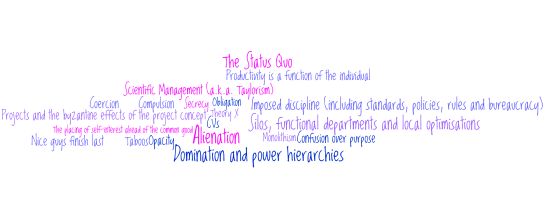How to Map a Memeplex
How to Map a Memeplex
“We often spend so much time coping with problems along our path that we forget why we are on that path in the first place. The result is that we only have a dim, or even inaccurate, view of what’s really important to us.”
~ Peter M. Senge
I’m presently embroiled in looking for one or more new opportunities, job-wise. As the founder of the #NoCV movement, I feel it would be disingenuous – to say the least – to write a CV (a.k.a. Resume) and punt that out in response to the various openings that may come up.
Honestly, I’m thoroughly sick of the whole damn mess that is job-hunting today. Not to mention the concept of “job” – as commonly understood.
And I’m sure I wouldn’t want to work for or even with organisations that either are so inflexible and unimaginative as to demand a CV, or so disinterested in hiring good people that they have no knowledge of or investment in how their recruiters (internal, HR, or external, agencies) are tackling their brief.
I realise this somewhat limits the field, but I see that as being in a good way. As I am wont to tweet occasionally:
“There is no talent shortage, only a shortage of organisations where talent wants to work.”
~ @FlowchainSensei
That’s definitely true in my case.
The #NoCV Alternative
I have written and presented on several occasions about what I see as some much-preferrable alternatives to CVs. Aside: As a general principle, I see little value in setting myself agin things without at least offering viable alternatives.
“When recruiting, look for mindset, not experience. Mindset is the determinant of effectiveness; experience often a blocker. #NoCV”
~ @FlowchainSensei
In fact, as a regular CV serves at least three purposes, I have (separate) alternatives for these threee purposes (and other alternatives in mind too, as yet unmentioned):
- Filtering applicants. When seeking to make a new hire, an organisation or recruiter will likely receive many dozens or even hundreds of applications. Most often, these applications are winnowed-down through cursory (i.e. 15-second) glances at their CVs, and/or by means of automated keywords matching software run agains their CVs. I’m not going to elaborate further on the folly of this here today. My proposed alternative is to require each applicant to complete a quick questionnaire (of say ten multiple choice questions) to identify their general mindset. This can then be matched against the kind of mindset the organisation wishes its new hires to play into.
- Selecting applicants for interview. From the filtered list of applicants, recruiters, hiring managers and (all too rarely) co-workers will wish to select a few candidates for closer scrutiny before making a hiring offer of some kind. Conventionally, this is done by a (slightly) more thorough read-through of the CVs of all the now-filtered list of applicants. My proposed alternative here is for each candidate to present their perspective on the world of work, and the way in which, ideally, work should work. Put another way, the candidate is invited to present their mindset regarding the world of work. I myself have chosen to go about this by means of an (interactive, web-based) graphic representation of my “preferred world of work mindset” a.k.a. memeplex. Aside: It may come as little surprise to regular readers to hear this is, essentially, congruent with what I refer to in the Marshall Model as the “Mature Synergistic” world view.
- Guiding the interview. Before and during each interview (whether more or less formal), interviewers often use a CV to prompt questions and topics for discussion. And maybe after the interview, the interviewer will use a CV to remind himself or herself of the candidates’ particulars, and interview responses. I suggest the representation provided as described in 2. can serve this purpose, as an alternative to the CV, also.
Representation of a Memeplex
So the question I’m playing with at the moment is: how to effectively represent a memeplex? After much searching on the Intarwebs, I have not been able to find any suitable, commonly accepted format for such a representation. Undaunted, I’ve resolved to come up with something myself (using e.g. HTML5, in case you’re wondering).
If you know of any suitable representation format, convention or even tool that I may have overlooked, do please let me know – before I invest too much time in reinventing that particular wheel. Note: As a long-time mind-mapper, I considered that route before rejecting it as not quite close enough. I may change my mind on that later. 🙂
Here’s an image of a (very) early prototype of the Analytic Mindset memeplex (this created using Wordle). BTW, don’t get too hung up on the actual content here.
I envisage each meme (phrase or tag, in the above Wordle) highlighting – and providing a link to an extended explanation of that particular meme – as the reader mouses over it. And maybe it would be useful to simultaneously highlight interlocking (related, reinforcing or countervailing) memes, too. Something – in expressiveness, at least – like the System Archetype diagrams of Senge.
GIven that this representation needs to stand alone, i.e. “speak” to its audience (e.g. potential interviewers) in the absence of its authors, some form of document (or maybe audio, video) seems necessary (see: Purpose 2., above). At least it’s not MSWord (yet). Sigh.
And of course, any hope of adoption rests in making these “memeplex maps” easy – for authors, the candidates – to create and share. And likewise – for recruiters and e.g. interviewers – straightforward to read and understand.
Next Steps
I continue to play with my evolving answer to the question of how to represent (map) a memeplex. I hope to have something more beta to share with you soon.
Any suggestions or comments gratefully received.
– Bob
Further Reading
QAME: a framework for understanding software teams ~ Blog post by Paul Klipp



Nice idea; though depending on what type of work the person may be performing, some skills may need to wind up in a corresponding skillsplex. For example, if I have a legacy code base in Java and I have had thorny problems, I’d like to know the person has dealt with some similar issues. Now she may have dealt with these kinds of issue sin say .Net and has only some rudimentary Java understanding, so again a keyword search on a resume isn’t going to reveal her talents, but certainly some questions along the technical nature of the work could help me identify her as a suitable person to open a conversation with…
The memeplex concept is a great addition as this what would tell me whether she could step up to learning Java and work with the team enough to be effective.
Cheers,
Paul
Great post, NoCV is getting better and better explained.
I’ve got a suggestion as an alternative to “Selecting applicants” – setup video recording interviews where applicants are not prepared to the question. Ask to answer a set of questions and evaluate before sending the interviewee to a meeting. To technical? Maybe. But it would save time from me as an interviewer
The video is to see facial expressions – how does the applicant repsond to a question such as “we have x and ask you for a suggestion” or “How do you implement a Y?”. As a interviewer in actual meeting, I can often tell after a few simple questions if the applicant is a match. To have this discussions in a one-way interaction would certainly speed up the selection, save the applicant from spending time on a interview that actually ended after the first question.
Thanks for sharing!
Gunnar
I think the idea of representing a memeplex needs some representation of foundational and ancillary ideas (for example, while eating pork is a no-no in e.g. Judaism it’s not really a defining characteristic of the memeplex). So I think at the least that might be useful, beyond just the frequency count of represented by a Wordle. Although I guess that would be starting to impose an analytic mindset on the memeplex which may not be desirable.
Memeplex’s are also a function of their environment which I would also be interested in (I guess the phenotypic approach).
I have been interviewing prospective employees using NLP Meta Programs based questions. It is interesting to watch and hear the reactions of those who were expecting a competency based or other corporate style interview. This system of interviewing could be adapted and applied at the start of the process. The questions used were arrived at by using ‘Strategy elicitation’ on staff who were already very effective in the role, they were identified by measuring Flow and then investigating.
Thanks for an interesting and stimulating post.
Martin @internalchoice
Back in “the day” when XML was new I actually wrote my CV in XML and then did an XSLT transform for it back to a doc – I distributed the XML & CV (boy was a geek back then! ;). I eventually abandoned this after a year or so as no one was really interested. I’m wondering if you could do similar, so you have a base “information set” that you can then slice & dice..? I suppose that HTML 5 will do all that and more – looking forward to see what you come up with.
Recently, I’ve been thinking of “modelling myself” in UML (still used in most places I work ;). Archimate could be interesting also as it’s a “softer notation” with symbols for Goals, Principles etc…
Thanks for getting practical on this, Bob!
Love the mindset match approach. Paul has an important point, though — and “skillsplex” sounds cool. 🙂
This would get so much easier for all parties if we would start stating our actual needs (“we need someone who helps cleaning up our 10yo legacy mess of Java, VB and something loosely resembling php”) instead of posting wishful dreams (“we are looking for the perfect Java expert with excellent SQL…”).
Then potential candidates could a) check if they have passion (remember that means suffering in Greek) for that particular challenge, that particular pain in the system. And b) we could much easier visualise and talk about the skillsplex idea that Paul introduced…
I highly recommend Thom Bradford’s presentation on organisational honesty on this topic: http://www.kode4food.it/careers-presentation/#/
Pingback: What is systems thinking? (Part II) « quantum shifting
Bob,
Wonder if you may have explored the possibility of using something called “Concept Maps” to explore & map out the “NoCV” and a more generally to explore the “memeplex” of any idea / process / situation.
Info on Concept Maps here at: http://cmap.ihmc.us/
With Best Regards
Shyam